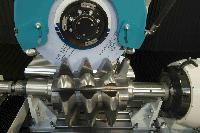Cutting Tool Sharpener Handles Large Diameter Hobs

"The need for larger hobs is created by wind generation. Larger gears demand larger hobs," explains Rolf Herrmann, general manager for J. Schneeberger. "Mining, large machinery, drilling (and) coal are other fields and industries where large hobs are required. Of course the tooling has been around for a long time but machine manufactures making machines for that market have diminished.
"In the tool grinding market, there are maybe three manufacturers left that will build machines up to three meters in travel length, machines to accept long tools such as broaches, long hobs, any long tool needed to be thread ground. In the last 10 years, Schneeberger has supplied that specialty market with the most sophisticated machine in design and technology."
The Corvus tool grinding machine is available in five- and six-axis versions and in different machine lengths to accommodate longer or heavier parts. The hob grinder relies on high horsepower to meet the substantial contact area sharpening that large hobs require. A 52 horsepower (78 horsepower duty cycle) direct drive motor is responsible for high stock removal and productive cycle times.
The machine is designed with a traveling column and stationary tool table, so extremely heavy tools can be set up on the table. The 1,200 Nm torque drive positions any tool quickly and accurately to meet quality requirements for indexing. Fanuc 310i technology is employed; linear drive motors provide accurate positioning. Other features include high rates of linear axis acceleration and deceleration and high positioning accuracy, cycle times and part quality.
The machine's base is constructed of polymer concrete to increase thermal stability and reduce vibration. The Schneeberger Quinto5 software was developed to support operators preparing a tool. The software features a large tool and wheel database, a graphical and interactive touch screen interface for quick tool programming. The tools are simulated instantly in 3-D format and can be edited as needed by clicking on a desired geometry. "The ability to develop the software in the same location as the machine enables the software, mechanical and application engineers to fine tune the final product, our software, in the shortest period of time," Herrmann says.
"Other machine manufacturers are not equipped to develop software in house and rely on outside sources, which makes the R&D very time consuming and difficult."





